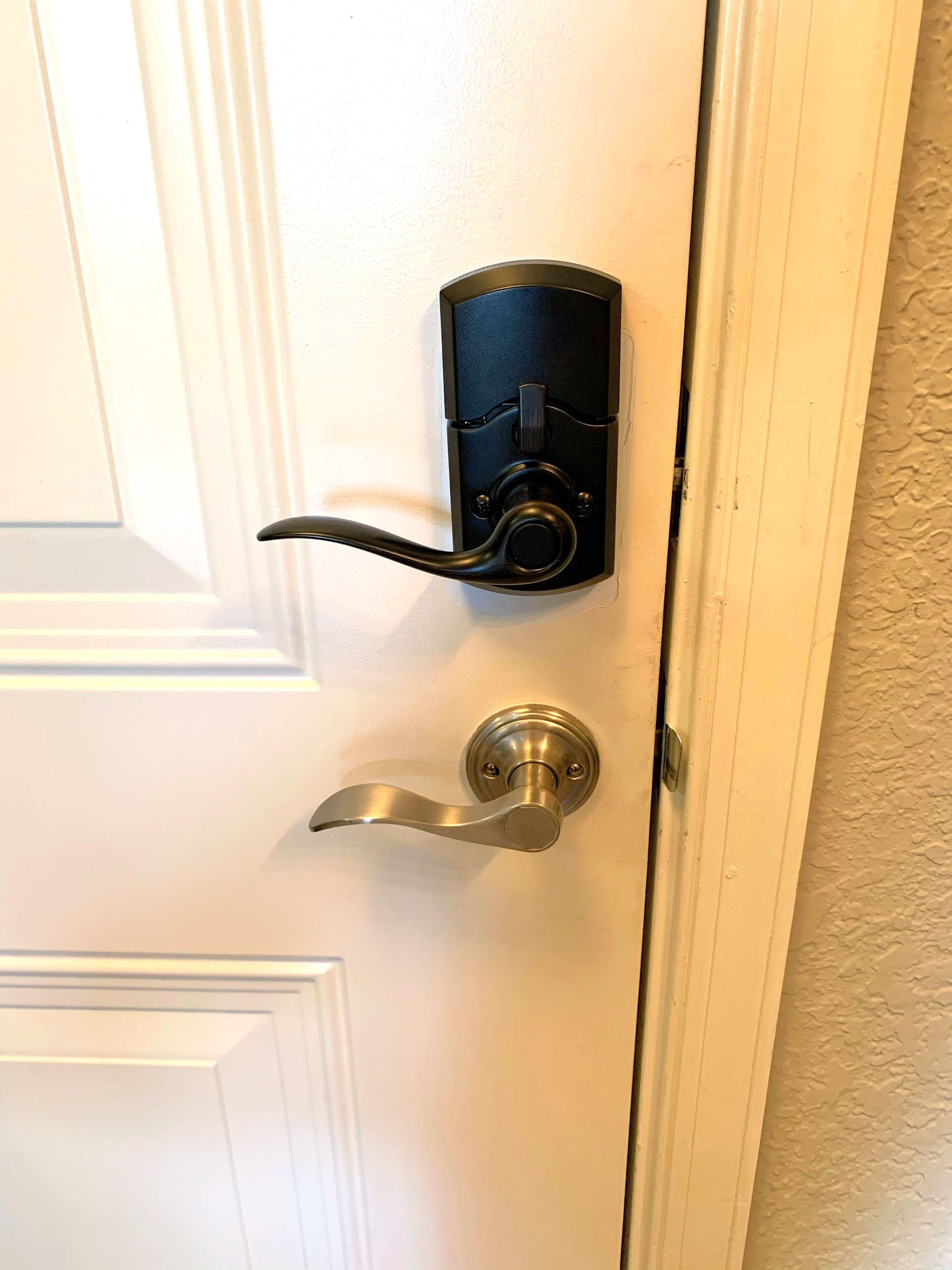 Have you ever been SO SURE about something that when you search unsuccessfully for confirmation you start to question what else you might have missed?
Have you ever been SO SURE about something that when you search unsuccessfully for confirmation you start to question what else you might have missed?
Andy Lindenberg of Allegion sent me this photo – it’s the entrance door to an apartment. We both knew that this was not acceptable – two latching devices that would require simultaneous operation with two hands in order to open the door. In addition to the egress and accessibility issues, it must be a total pain for the residents.
I’ve written before about the requirement for most doors in a means of egress to unlatch with one releasing motion. One of the exceptions to that requirement is on the entrance doors to residential dwelling units and sleeping units. These doors are allowed by the IBC and NFPA 101 to have a “night latch, deadbolt, or security chain” in addition to the latching hardware.
While the second lock in Andy’s photo is not a deadbolt, the language from NFPA 101 specifically includes automatic latching devices when describing the types of security devices that are allowed. Clearly, the application in the photo is a bad idea, but I always like to have something in the code to back up my opinion.
To my surprise, there is something missing from both the IBC and NFPA 101 – language which states that the two releasing motions for the security devices must be non-simultaneous. This would allow the door to be unlatched with one hand, and without the coordination and dexterity that would be required to operate the hardware in the photo.
The 2021 code sections are below (in case you’re doubting me 🙂 ). This change is now on my wish list to fix in future editions of the model codes. In the meantime, keep in mind that most apartments are required to comply with the Fair Housing Act, which references the accessibility standards. Both the ADA Standards for Accessible Design and ICC/A117.1 Accessible and Usable Buildings and Facilities require hardware that is operable with one hand. From a common-sense standpoint, the entrance door shown in the photo would not comply.
2021 IBC:
1010.2.4 (5) Doors from individual dwelling or sleeping units of Group R occupancies having an occupant load of 10 or less are permitted to be equipped with a night latch, dead bolt or security chain, provided such devices are openable from the inside without the use of a key or tool.
2021 NFPA 101:
7.2.1.5.3.4* Egress door assemblies from individual living units and guest rooms of residential occupancies shall be permitted to be provided with devices, including automatic latching devices, that require not more than one additional releasing operation, provided that such device is operable from the inside without the use of a key or tool and is mounted at a height not exceeding 48 in. (1220 mm) above the finished floor.
A.7.2.1.5.3.4 Examples of devices that, when used with a latch, can be arranged to require not more than one additional releasing operation include night latches, dead bolts, and security chains.
If you ever find something missing from the model codes or referenced standards, let me know and I’ll put it on my wish list!
You need to login or register to bookmark/favorite this content.





Lori,
The bottom line is no more than two operations are allowed for Group R specifically. Example: 1) a door knob with or with out a integral dead bolt that release upon lever being activation 2) a separate dead bolt latch not integral to the lever or security chain but not both? A nigh latch, dead bolt or security chain is allowed but not all three, right?
Hi Donnie –
The way I would interpret the model codes is this: These doors will typically have latching hardware. This lock could have an integral deadbolt or not, with all latches/bolts retracted with one releasing motion. In addition, the door could have one other security device – a deadbolt, chain, door guard, etc., as long as a key is not required for egress. Note that the IBC limits this extra security device to doors serving units with an occupant load of 10 people or less (2000 square feet). NFPA 101 limits the mounting height to 48 inches AFF, but generally all operable hardware would be between 34-48 inches AFF. Also, this exception applies to Group R (residential), so if you have assisted living units that are Group I, for example, the exception would not apply.
Here’s a little more info: https://idighardware.com/2018/08/dwelling-unit-clarifications/
– Lori
I have found that many Texas codes require a thumb turn deadbolt on apartment entry doors. Still requires two operations but can be done with one hand.
Hi Mike –
Two unlatching operations are allowed by the model codes for residential dwelling and sleeping units, and as you said, some state and city codes require the extra lock for security. It’s just the need for two simultaneous motions that creates a problem.
– Lori
Took awhile,, I do see the point.
Yep, not sure why the set up was approved.???